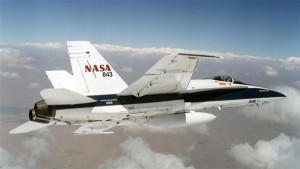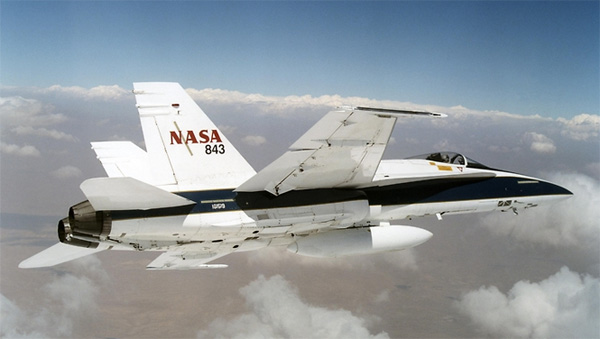 According to information in a recent NASA press release, the return of supersonic passenger travel on airlines could be closer to reality. It’s all thanks to the agency’s efforts to define a new standard for low sonic booms.
According to information in a recent NASA press release, the return of supersonic passenger travel on airlines could be closer to reality. It’s all thanks to the agency’s efforts to define a new standard for low sonic booms.
Long before the retirement of the Concord aircraft, supersonic airline travel was banned over the continental U.S. because of the sonic booms created, and some broken windows left on the ground in their wake. But researchers hope to change that.

NASA F/A-18 mission support aircraft were used to create low-intensity sonic booms during a resaerch project at the agency’s Armstrong Flight Research Center in Edwards, California. Credit: NASA/Jim Ross
At the Aviation 2014 gathering in Atlanta GA this week, an annual event of the American Institute of Aeronautics and Astronautics, researchers will be sharing progress they are making in overcoming some of the biggest hurdles to supersonic passenger air travel.
According to NASA, the research generates data crucial for developing a low-boom standard for the civil aviation industry. NASA works closely with the Federal Aviation Administration and the international aerospace community, including the International Civil Aviation Organization, to gather data and develop new procedures and requirements that may help in a reconsideration of the current ban on supersonic flight over land.
“Lessening sonic booms — shock waves caused by an aircraft flying faster than the speed of sound — is the most significant hurdle to reintroducing commercial supersonic flight,” said Peter Coen, head of the High Speed Project in NASA’s Aeronautics Research Mission Directorate at the agency’s Headquarters in Washington. “Other barriers include high altitude emissions, fuel efficiency and community noise around airports.”
A recent flight research campaign at NASA’s Armstrong Flight Research Center in Edwards, California, had residents explore ways to assess the public’s response to sonic booms in a real-world setting. Researchers at Armstrong have an advantage — pilots are permitted to fly at supersonic speeds because the facility is located on Edwards Air Force Base.
Similar work is conducted at NASA’s Langley Research Center in Hampton, Virginia, where volunteers from the local community rated sonic booms according to how disruptive they determined the sound to be.
NASA and industry engineers say they believe supersonic research has progressed to the point where the design of a practical low-boom supersonic jet is within reach.
Read more about NASA’s supersonic flight research online at: http://go.nasa.gov/1uATkF5
![Herbal Reference Substances are Key to Everyday Products <!-- AddThis Sharing Buttons above -->
<div class="addthis_toolbox addthis_default_style " addthis:url='http://newstaar.com/herbal-reference-substances-are-key-to-everyday-products/3512112/' >
<a class="addthis_button_facebook_like" fb:like:layout="button_count"></a>
<a class="addthis_button_tweet"></a>
<a class="addthis_button_pinterest_pinit"></a>
<a class="addthis_counter addthis_pill_style"></a>
</div>When it comes to quality control testing and the development of new products, Botanical Reference Materials (BRMs), also known as Herbal References are critically important. To help companies ultimately obtain all-important FDA approval, the Food and Drug Administration provides in its guidance a recommendation that […]<!-- AddThis Sharing Buttons below -->
<div class="addthis_toolbox addthis_default_style addthis_32x32_style" addthis:url='http://newstaar.com/herbal-reference-substances-are-key-to-everyday-products/3512112/' >
<a class="addthis_button_preferred_1"></a>
<a class="addthis_button_preferred_2"></a>
<a class="addthis_button_preferred_3"></a>
<a class="addthis_button_preferred_4"></a>
<a class="addthis_button_compact"></a>
<a class="addthis_counter addthis_bubble_style"></a>
</div>](http://newstaar.com/wp-content/uploads/2021/02/Achillea_millefolium_flowers-100x100.jpg)
![Quality Electrochemical Biosensors are Critical for Medical, Food and Chemical Industry <!-- AddThis Sharing Buttons above -->
<div class="addthis_toolbox addthis_default_style " addthis:url='http://newstaar.com/quality-electrochemical-biosensors-are-critical-for-medical-food-and-chemical-industry/3512086/' >
<a class="addthis_button_facebook_like" fb:like:layout="button_count"></a>
<a class="addthis_button_tweet"></a>
<a class="addthis_button_pinterest_pinit"></a>
<a class="addthis_counter addthis_pill_style"></a>
</div>A number of industries have, at their core, a need to frequent or even continuous analysis of biological media. These include the medical and pharmaceutical fields, biotech firms, and food and chemical companies. To maintain quality standards and develop new products, these industries rely heavily […]<!-- AddThis Sharing Buttons below -->
<div class="addthis_toolbox addthis_default_style addthis_32x32_style" addthis:url='http://newstaar.com/quality-electrochemical-biosensors-are-critical-for-medical-food-and-chemical-industry/3512086/' >
<a class="addthis_button_preferred_1"></a>
<a class="addthis_button_preferred_2"></a>
<a class="addthis_button_preferred_3"></a>
<a class="addthis_button_preferred_4"></a>
<a class="addthis_button_compact"></a>
<a class="addthis_counter addthis_bubble_style"></a>
</div>](http://newstaar.com/wp-content/uploads/2020/10/Electrochemical-Biosensor-100x100.jpg)
![Company Develops Industrial Mixers Well-Suited for both Fragile and Explosive Products <!-- AddThis Sharing Buttons above -->
<div class="addthis_toolbox addthis_default_style " addthis:url='http://newstaar.com/company-develops-industrial-mixers-well-suited-for-both-fragile-and-explosive-products/3512071/' >
<a class="addthis_button_facebook_like" fb:like:layout="button_count"></a>
<a class="addthis_button_tweet"></a>
<a class="addthis_button_pinterest_pinit"></a>
<a class="addthis_counter addthis_pill_style"></a>
</div>Industrial drum mixers are normally applied to blend mixes of varying viscosities such as adhesive slurries or cement. Some of these mixers have the capability of blending mixes of very different particle sizes such as fruit and ice cream, and gravel and cement slurry. The […]<!-- AddThis Sharing Buttons below -->
<div class="addthis_toolbox addthis_default_style addthis_32x32_style" addthis:url='http://newstaar.com/company-develops-industrial-mixers-well-suited-for-both-fragile-and-explosive-products/3512071/' >
<a class="addthis_button_preferred_1"></a>
<a class="addthis_button_preferred_2"></a>
<a class="addthis_button_preferred_3"></a>
<a class="addthis_button_preferred_4"></a>
<a class="addthis_button_compact"></a>
<a class="addthis_counter addthis_bubble_style"></a>
</div>](http://newstaar.com/wp-content/uploads/2020/06/bandeau-sofragir2-100x100.jpg)